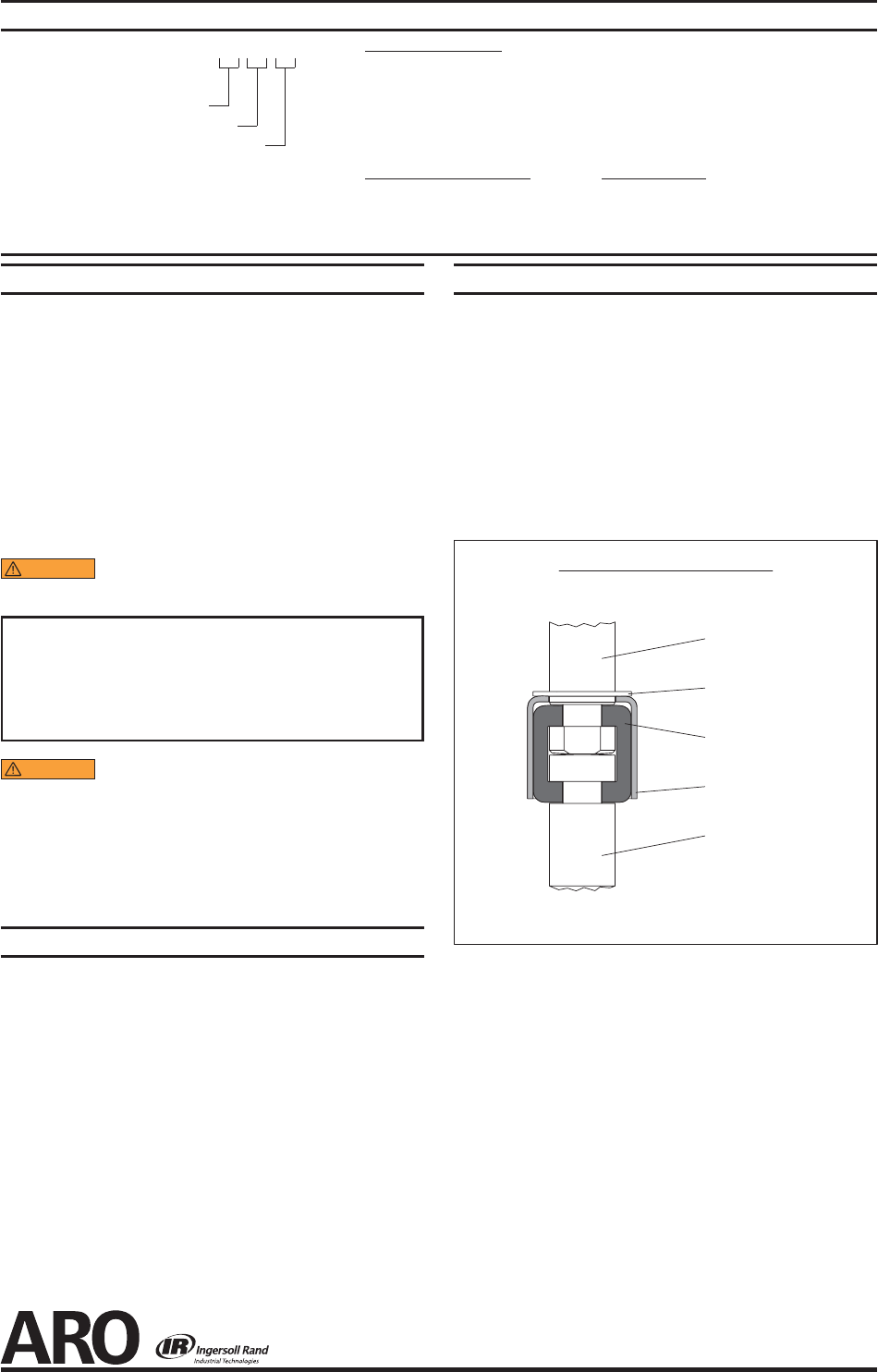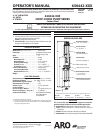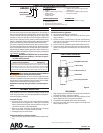
Page 2 of 2 650442-XXX (en)
PN 97999-1190
GENERAL DESCRIPTION
The chop-check pumps are primarily designed for the pumping of
heavy viscous material with or without brous content. The models
can be used with a gravity feed single post lift as a topper type
assembly or with a two post lift as a force feed type assembly. The
lower pump is designed for easy priming and the double acting
feature is standard in all ARO industrial pumps. Material is delivered
to the pump discharge outlet on both the up and down stroke.
The motor is connected to the lower pump end by a spacer section.
This allows for lubrication of the upper packing gland and prevents
motor contamination because of normal wear and eventual leak-
age through the material packing gland. Be sure the solvent cup is
adequately lled with lubricant to protect the upper packings and
insure longest service life.
WARNING
HAZARDOUS PRESSURE. Do not exceed maxi-
mum operating pressure of 600 p.s.i. (41.4 bar) at 150 p.s.i.
(10.3 bar) inlet air pressure.
Pump Ratio X = Maximum Pump
Inlet Pressure to Pump Motor Fluid Pressure
Pump ratio is an expression of the relationship between the pump motor area
and the lower pump end area. EXAMPLE: When 150 p.s.i. (10.3 bar) inlet pressure
is supplied to the motor of a 4:1 ratio pump, it will develop a maximum of 600
p.s.i. (41.4 bar) uid pressure (at no ow) - as the uid control is opened, the ow
rate will increase as the motor cycle rate increases to keep up with the demand.
WARNING
Refer to general information sheet for additional
safety precautions and important information.
NOTICE: Thermal expansion can occur when the uid in the mate-
rial lines is exposed to elevated temperatures. Example: Material
lines located in a non-insulated roof area can warm due to sunlight.
Install a pressure relief valve in the pumping system.
Replacement warning label (pn 92325) is available upon re-
quest.
TROUBLE SHOOTING
Pump problems can occur in either the air motor section or the
lower pump end section. Use these basic guidelines to help deter-
mine which section is a ected.
Pump will not cycle.
Be certain to first check for non-pump problems including
kinked, restrictive or plugged inlet / outlet hose or dispensing
device. Depressurize the pump system and clean out any ob-
structions in the inlet / outlet material lines.
Refer to the motor manual for trouble shooting if the pump
does not cycle and / or air leaks from the air motor.
Damaged motor. Service the motor.
Pump cycles but does not deliver material.
Refer to the lower pump end manual for further trouble shoot-
ing.
PUMP OPTION DESCRIPTION CHART
650422- X X X
Packing Material
Spring Arrangement
Plunger Type
PACKING MATERIAL
(Packings are upper and lower unless noted)
3 - Glass lled PTFE P - UHMW-PE / Glass lled PTFE staggered (upper)
C - UHMW-PE UHMW-PE (lower)
F - UHMW-PE / Leather staggered (upper) R - Glass lled PTFE / UHMW-PE staggered (upper)
UHMW-PE (lower) Glass lled PTFE (lower)
J - Polyurethane (upper)
UHMW-PE (lower)
SPRING ARRANGEMENT PLUNGER TYPE
3 - No spring H - Carbon steel with hard chrome plating
4 - Multiple wave spring
8 - No spring with alternate solvent cup
9 - Multiple wave spring with alternate solvent cup
ARO® is a registered trademark of Ingersoll Rand
PUMP CONNECTION - UPPER / LOWER
NOTE: All threads are right hand.
Lay the pump assembly on a work bench.
Remove the three (79186) cap screws from the three spacer
rods (see gure 1).
Pull the air motor from the lower pump end until the motor
piston rod is in the “down” position and the lower pump end
rod is in the “up” position.
Unscrew and remove the three spacer rods from the air motor.
Using e-ring pliers, slide the “e” ring up far enough to allow the
sleeve to move upward and release the two connectors (see
gure 2).
PUMP CONNECTION DETAIL
Pump Motor Piston Rod
91547 “E” Ring
Lower Pump Piston Rod
91644 Connector (2)
91546 Sleeve
Figure 2
REASSEMBLY
Align the pump motor with the lower pump end. Position the
air inlet of the motor 4° from the air exhaust.
Install the two (91644) connectors and retain with the (91546)
sleeve. Slide the (91547) “e” ring back into position.
Assemble the three (96038) spacer rods to the air motor.
Bring the motor and lower pump together and retain with
three (79186) cap screws.
1.
2.
3.
4.
5.
1.
2.
3.
4.




